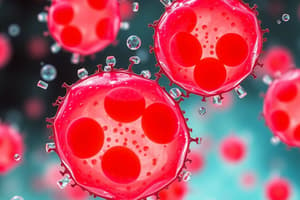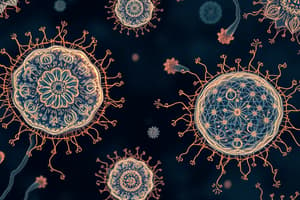Podcast
Questions and Answers
What is the function of ions in cellular mechanisms?
What is the function of ions in cellular mechanisms?
- To transmit electrochemical impulses in nerve and muscle cells (correct)
- To provide energy for cellular reactions
- To catalyze biochemical reactions
- To store genetic information
What is the main component of most cells?
What is the main component of most cells?
- Proteins
- Water (correct)
- Lipids
- Carbohydrates
What is the function of proteins in cells?
What is the function of proteins in cells?
- To mediate physiological changes (correct)
- To store energy
- To regulate gene expression
- To provide structural support
What is the main function of carbohydrates in cells?
What is the main function of carbohydrates in cells?
What is unique about the composition of fat cells (adipocytes)?
What is unique about the composition of fat cells (adipocytes)?
Where can chemical reactions involving water take place within a cell?
Where can chemical reactions involving water take place within a cell?
What is the primary function of cholesterol in the cell membrane?
What is the primary function of cholesterol in the cell membrane?
What type of protein is typically responsible for transporting molecules across the cell membrane?
What type of protein is typically responsible for transporting molecules across the cell membrane?
Which lipids are found in high quantities within the cell membrane?
Which lipids are found in high quantities within the cell membrane?
What is the primary function of peripheral proteins in the cell membrane?
What is the primary function of peripheral proteins in the cell membrane?
Which of the following is a primary function of the cell membrane?
Which of the following is a primary function of the cell membrane?
What is the primary function of cholesterol in the cell membrane?
What is the primary function of cholesterol in the cell membrane?
What is the main difference in ion distribution between the ICF and ECF?
What is the main difference in ion distribution between the ICF and ECF?
Which organelle is described as being "a netlike labyrinth of branching tubules and flattened sacs that extends throughout the cytosol"?
Which organelle is described as being "a netlike labyrinth of branching tubules and flattened sacs that extends throughout the cytosol"?
Adipocytes are composed of triglycerides. What is the function of adipocytes?
Adipocytes are composed of triglycerides. What is the function of adipocytes?
What is the term for the voltage difference caused by the uneven distribution of ions on opposite sides of the cell membrane?
What is the term for the voltage difference caused by the uneven distribution of ions on opposite sides of the cell membrane?
What is the characteristic of lipids that allows them to play a key role in the cell’s membrane-bound organelles?
What is the characteristic of lipids that allows them to play a key role in the cell’s membrane-bound organelles?
Which organelle is responsible for breaking down hydrogen peroxide?
Which organelle is responsible for breaking down hydrogen peroxide?
What is the role of phospholipids in the cell membrane?
What is the role of phospholipids in the cell membrane?
Which organelle is involved in the process of bile acid synthesis?
Which organelle is involved in the process of bile acid synthesis?
What is the primary mechanism by which mitochondria generate energy for the cell?
What is the primary mechanism by which mitochondria generate energy for the cell?
What is the difference between the cytosol and cytoplasm?
What is the difference between the cytosol and cytoplasm?
What is the primary function of lysosomes in cellular activity?
What is the primary function of lysosomes in cellular activity?
What is the primary function of the smooth endoplasmic reticulum?
What is the primary function of the smooth endoplasmic reticulum?
What type of cytoskeleton is actin?
What type of cytoskeleton is actin?
What is the function of the rough endoplasmic reticulum?
What is the function of the rough endoplasmic reticulum?
Which organelle is described as being a "collection of flattened, membrane-enclosed compartments called cisternae"?
Which organelle is described as being a "collection of flattened, membrane-enclosed compartments called cisternae"?
What is the function of the membrane potential?
What is the function of the membrane potential?
What is the function of the ER in terms of intracellular calcium storage?
What is the function of the ER in terms of intracellular calcium storage?
What is the relationship between the ER and the Golgi apparatus?
What is the relationship between the ER and the Golgi apparatus?
What is the primary function of the golgi apparatus in cellular activity?
What is the primary function of the golgi apparatus in cellular activity?
Flashcards are hidden until you start studying
Study Notes
Cellular Organelles and Components
- Golgi Apparatus:
- Processes and forms lysosomes, secretory vesicles, and other cytoplasmic components
- Lysosomes:
- Vesicular organelles composed of digestive enzyme hydrolase
- Digest unwanted matter, food particles, and damaged cell structures
- Major site of intracellular digestion
- Peroxisomes:
- Vesicular organelles formed via self-replication or ER formation
- Contain at least 50 different enzymes, including oxidases and catalases
- Involved in lipid biosynthesis, such as bile acid synthesis in hepatocytes
- Mitochondria:
- Uses oxidative phosphorylation to generate ATP for cellular energy
- Tissues with high energy demands have more mitochondria
- Capable of self-replication
Cellular Components
- Cytoskeleton:
- Network of fibrillar proteins organized into microtubules, intermediate filaments, and microfilaments
- Actin is an example of a microfilament
- Water:
- Polar molecule and major component of most cells (except adipocytes with 5% water and 95% lipid composition)
- Enables chemical reactions to occur at particle surfaces, in membranes, and among dissolved chemicals
- Carbohydrates:
- Typically used as a major energy source
- Stored in small quantities within cells as glycogen
- Can be combined with lipids or proteins for structural functions
- Proteins:
- 2nd most abundant substance in cells
- 3D shape impacts function and allows for specificity when binding
- Can alter shape to adjust function or binding properties
- Essential for mediating physiological changes
- Can be structural, functional, or have signaling roles
Ions and Lipids
- Ions:
- Polar, hydrophilic molecules necessary for cellular mechanisms
- Examples: phosphate, magnesium, sulfate, bicarbonate, potassium, sodium, chloride, calcium
- Can transmit electrochemical impulses in nerve and muscle cells
- Lipids:
- Non-polar molecules playing a key role in cell membrane-bound organelles
- Diverse, with functions not fully understood
- Examples: phospholipids, cholesterol, triglycerides
- Phospholipids and cholesterol make up the cell membrane and intracellular membrane barriers
- Triglycerides are composed of glycerol and three fatty acids
Cellular Processes
- Selective Transport:
- Processes and transmits information
- Membrane Potential:
- Generates an electrical charge influencing protein activity in the cell membrane
- Important in excitable cells for signal transmission
- Cytosol and Cytoplasm:
- Cytosol: fluid composition of the cell containing water, proteins, electrolytes, and glucose
- Cytoplasm: space between the cell membrane and nucleus containing organelles and cytosol
Endoplasmic Reticulum and Golgi Apparatus
- Endoplasmic Reticulum (ER):
- Network of netlike branching tubules and flattened sacs with a continuous membrane
- Smooth ER synthesizes lipids and is larger in cells with high lipid production
- Rough ER synthesizes proteins and has ribosomes attached
- Golgi Apparatus:
- Composed of flattened cisternae (membrane-enclosed compartments)
- Closely related to the ER, with vesicles fusing from the ER to the Golgi
Studying That Suits You
Use AI to generate personalized quizzes and flashcards to suit your learning preferences.




